Bow Valley College - MGMT1101: Uber's Management Analysis Final Report
VerifiedAdded on 2022/09/09
|12
|2309
|30
Report
AI Summary
This report provides a detailed analysis of Uber's management, focusing on environmental constraints, stakeholder identification, strategic planning, organizational structure, and control mechanisms. The report begins with an introduction to Uber, highlighting its global presence and market position. It then conducts a PESTLE analysis to identify political, economic, social, technological, legal, and environmental factors impacting the company. Key stakeholders, including customers, employees, partners, and investors, are identified and prioritized. The report further examines Uber's strategic management, including a SWOT analysis and proposed strategies for stakeholder engagement and corporate social responsibility. The organizational structure of Uber, characterized by a hierarchical structure, is also examined. Finally, the report provides recommendations for improvement, emphasizing the need for strategies to mitigate environmental impact and improve workplace culture. The report concludes by emphasizing Uber's dynamic and competitive operating environment.

Running head: INTRODUCTION TO MANAGEMENT
INTRODUCTION TO MANAGEMENT
Student’s Name
University Name
Author note
INTRODUCTION TO MANAGEMENT
Student’s Name
University Name
Author note
Paraphrase This Document
Need a fresh take? Get an instant paraphrase of this document with our AI Paraphraser
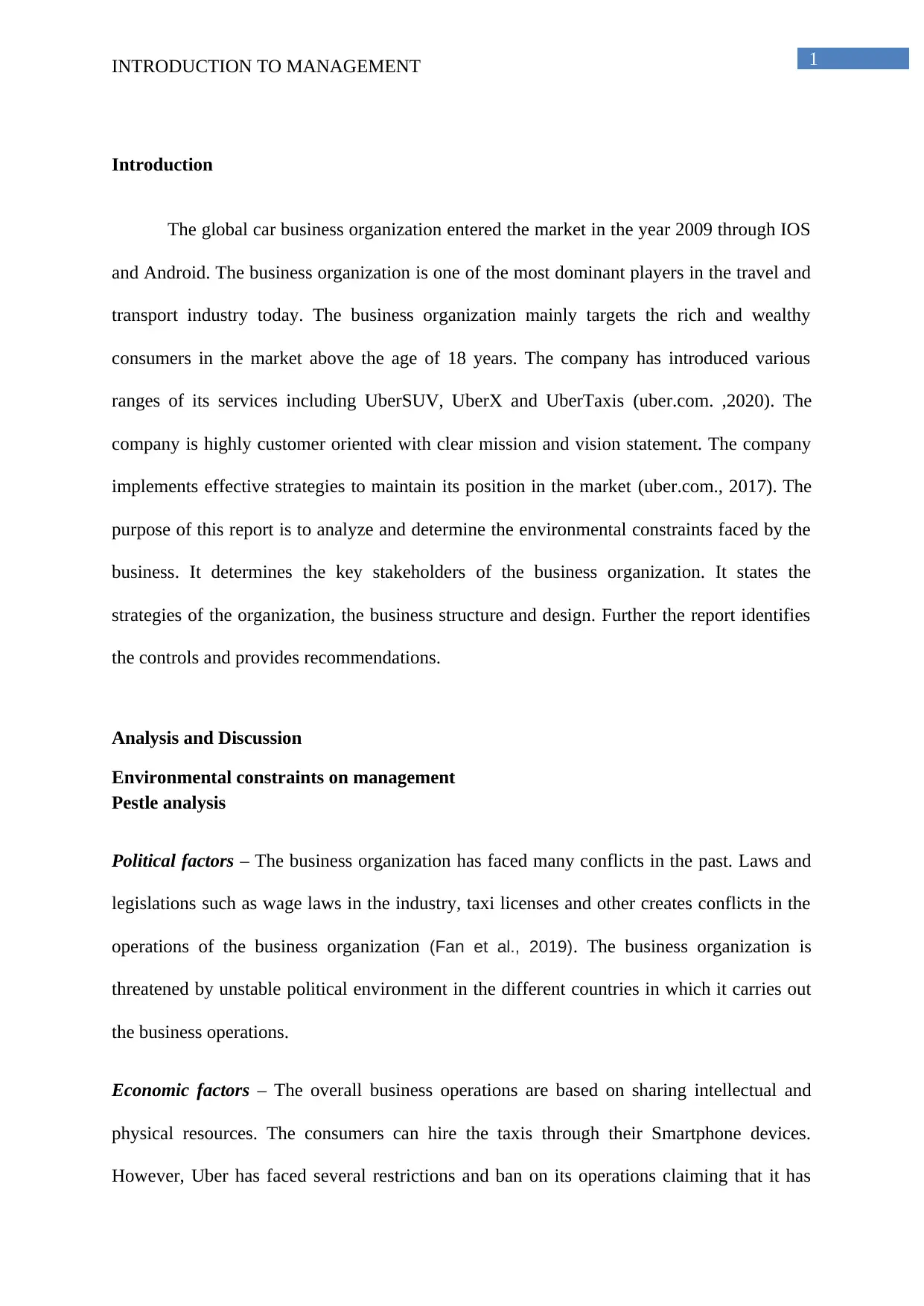
1INTRODUCTION TO MANAGEMENT
Introduction
The global car business organization entered the market in the year 2009 through IOS
and Android. The business organization is one of the most dominant players in the travel and
transport industry today. The business organization mainly targets the rich and wealthy
consumers in the market above the age of 18 years. The company has introduced various
ranges of its services including UberSUV, UberX and UberTaxis (uber.com. ,2020). The
company is highly customer oriented with clear mission and vision statement. The company
implements effective strategies to maintain its position in the market (uber.com., 2017). The
purpose of this report is to analyze and determine the environmental constraints faced by the
business. It determines the key stakeholders of the business organization. It states the
strategies of the organization, the business structure and design. Further the report identifies
the controls and provides recommendations.
Analysis and Discussion
Environmental constraints on management
Pestle analysis
Political factors – The business organization has faced many conflicts in the past. Laws and
legislations such as wage laws in the industry, taxi licenses and other creates conflicts in the
operations of the business organization (Fan et al., 2019). The business organization is
threatened by unstable political environment in the different countries in which it carries out
the business operations.
Economic factors – The overall business operations are based on sharing intellectual and
physical resources. The consumers can hire the taxis through their Smartphone devices.
However, Uber has faced several restrictions and ban on its operations claiming that it has
Introduction
The global car business organization entered the market in the year 2009 through IOS
and Android. The business organization is one of the most dominant players in the travel and
transport industry today. The business organization mainly targets the rich and wealthy
consumers in the market above the age of 18 years. The company has introduced various
ranges of its services including UberSUV, UberX and UberTaxis (uber.com. ,2020). The
company is highly customer oriented with clear mission and vision statement. The company
implements effective strategies to maintain its position in the market (uber.com., 2017). The
purpose of this report is to analyze and determine the environmental constraints faced by the
business. It determines the key stakeholders of the business organization. It states the
strategies of the organization, the business structure and design. Further the report identifies
the controls and provides recommendations.
Analysis and Discussion
Environmental constraints on management
Pestle analysis
Political factors – The business organization has faced many conflicts in the past. Laws and
legislations such as wage laws in the industry, taxi licenses and other creates conflicts in the
operations of the business organization (Fan et al., 2019). The business organization is
threatened by unstable political environment in the different countries in which it carries out
the business operations.
Economic factors – The overall business operations are based on sharing intellectual and
physical resources. The consumers can hire the taxis through their Smartphone devices.
However, Uber has faced several restrictions and ban on its operations claiming that it has
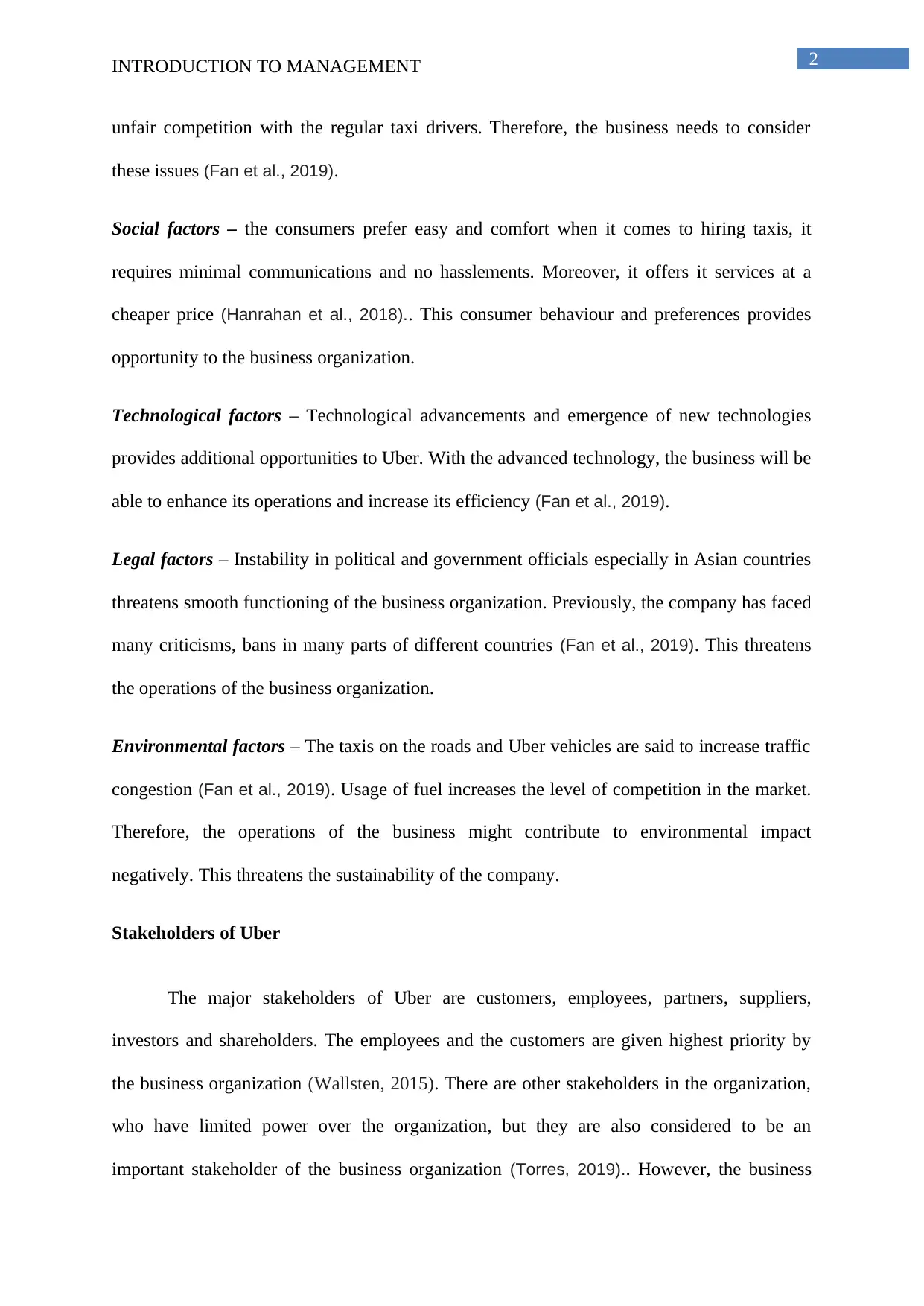
2INTRODUCTION TO MANAGEMENT
unfair competition with the regular taxi drivers. Therefore, the business needs to consider
these issues (Fan et al., 2019).
Social factors – the consumers prefer easy and comfort when it comes to hiring taxis, it
requires minimal communications and no hasslements. Moreover, it offers it services at a
cheaper price (Hanrahan et al., 2018).. This consumer behaviour and preferences provides
opportunity to the business organization.
Technological factors – Technological advancements and emergence of new technologies
provides additional opportunities to Uber. With the advanced technology, the business will be
able to enhance its operations and increase its efficiency (Fan et al., 2019).
Legal factors – Instability in political and government officials especially in Asian countries
threatens smooth functioning of the business organization. Previously, the company has faced
many criticisms, bans in many parts of different countries (Fan et al., 2019). This threatens
the operations of the business organization.
Environmental factors – The taxis on the roads and Uber vehicles are said to increase traffic
congestion (Fan et al., 2019). Usage of fuel increases the level of competition in the market.
Therefore, the operations of the business might contribute to environmental impact
negatively. This threatens the sustainability of the company.
Stakeholders of Uber
The major stakeholders of Uber are customers, employees, partners, suppliers,
investors and shareholders. The employees and the customers are given highest priority by
the business organization (Wallsten, 2015). There are other stakeholders in the organization,
who have limited power over the organization, but they are also considered to be an
important stakeholder of the business organization (Torres, 2019).. However, the business
unfair competition with the regular taxi drivers. Therefore, the business needs to consider
these issues (Fan et al., 2019).
Social factors – the consumers prefer easy and comfort when it comes to hiring taxis, it
requires minimal communications and no hasslements. Moreover, it offers it services at a
cheaper price (Hanrahan et al., 2018).. This consumer behaviour and preferences provides
opportunity to the business organization.
Technological factors – Technological advancements and emergence of new technologies
provides additional opportunities to Uber. With the advanced technology, the business will be
able to enhance its operations and increase its efficiency (Fan et al., 2019).
Legal factors – Instability in political and government officials especially in Asian countries
threatens smooth functioning of the business organization. Previously, the company has faced
many criticisms, bans in many parts of different countries (Fan et al., 2019). This threatens
the operations of the business organization.
Environmental factors – The taxis on the roads and Uber vehicles are said to increase traffic
congestion (Fan et al., 2019). Usage of fuel increases the level of competition in the market.
Therefore, the operations of the business might contribute to environmental impact
negatively. This threatens the sustainability of the company.
Stakeholders of Uber
The major stakeholders of Uber are customers, employees, partners, suppliers,
investors and shareholders. The employees and the customers are given highest priority by
the business organization (Wallsten, 2015). There are other stakeholders in the organization,
who have limited power over the organization, but they are also considered to be an
important stakeholder of the business organization (Torres, 2019).. However, the business
⊘ This is a preview!⊘
Do you want full access?
Subscribe today to unlock all pages.

Trusted by 1+ million students worldwide
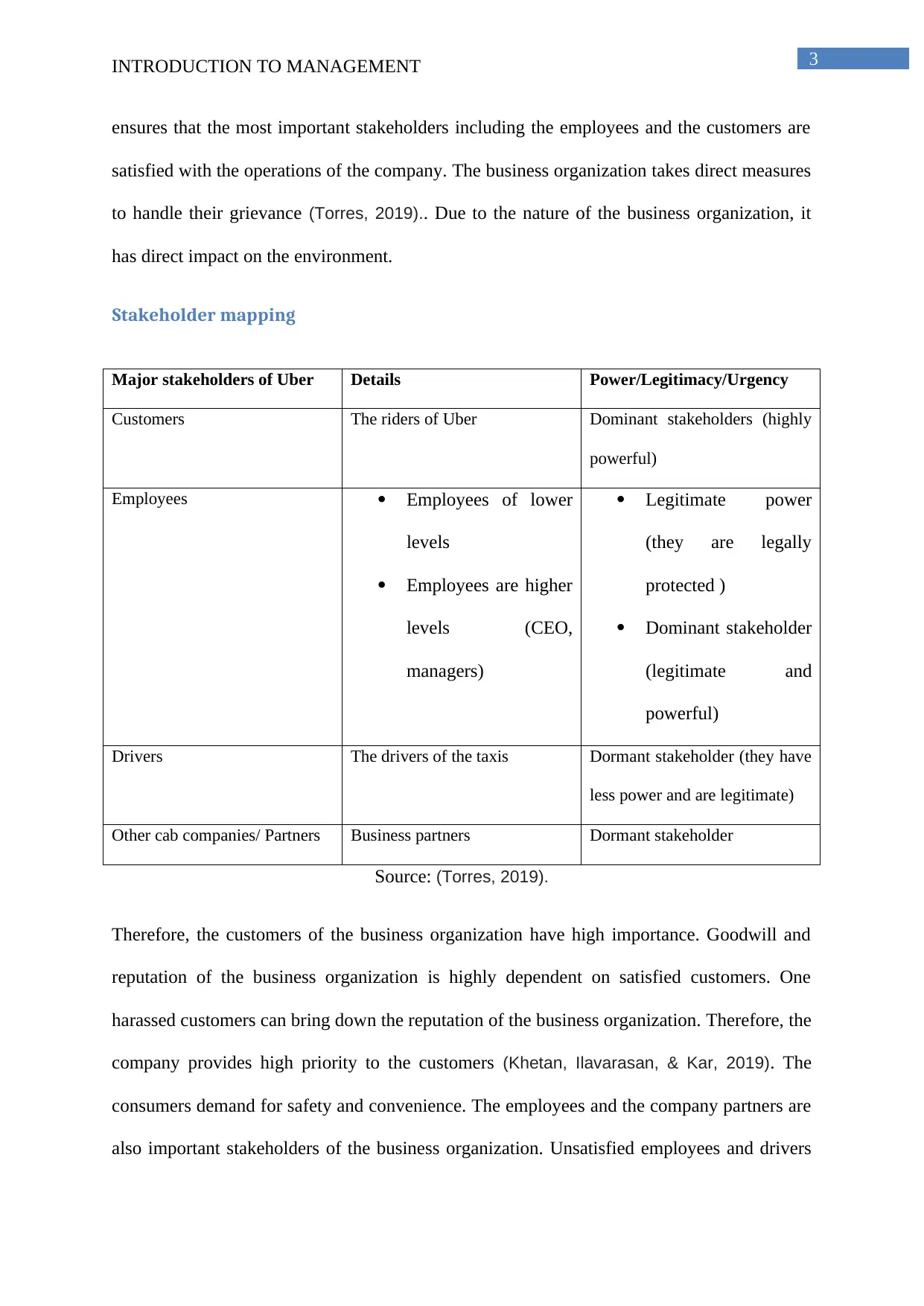
3INTRODUCTION TO MANAGEMENT
ensures that the most important stakeholders including the employees and the customers are
satisfied with the operations of the company. The business organization takes direct measures
to handle their grievance (Torres, 2019).. Due to the nature of the business organization, it
has direct impact on the environment.
Stakeholder mapping
Major stakeholders of Uber Details Power/Legitimacy/Urgency
Customers The riders of Uber Dominant stakeholders (highly
powerful)
Employees Employees of lower
levels
Employees are higher
levels (CEO,
managers)
Legitimate power
(they are legally
protected )
Dominant stakeholder
(legitimate and
powerful)
Drivers The drivers of the taxis Dormant stakeholder (they have
less power and are legitimate)
Other cab companies/ Partners Business partners Dormant stakeholder
Source: (Torres, 2019).
Therefore, the customers of the business organization have high importance. Goodwill and
reputation of the business organization is highly dependent on satisfied customers. One
harassed customers can bring down the reputation of the business organization. Therefore, the
company provides high priority to the customers (Khetan, Ilavarasan, & Kar, 2019). The
consumers demand for safety and convenience. The employees and the company partners are
also important stakeholders of the business organization. Unsatisfied employees and drivers
ensures that the most important stakeholders including the employees and the customers are
satisfied with the operations of the company. The business organization takes direct measures
to handle their grievance (Torres, 2019).. Due to the nature of the business organization, it
has direct impact on the environment.
Stakeholder mapping
Major stakeholders of Uber Details Power/Legitimacy/Urgency
Customers The riders of Uber Dominant stakeholders (highly
powerful)
Employees Employees of lower
levels
Employees are higher
levels (CEO,
managers)
Legitimate power
(they are legally
protected )
Dominant stakeholder
(legitimate and
powerful)
Drivers The drivers of the taxis Dormant stakeholder (they have
less power and are legitimate)
Other cab companies/ Partners Business partners Dormant stakeholder
Source: (Torres, 2019).
Therefore, the customers of the business organization have high importance. Goodwill and
reputation of the business organization is highly dependent on satisfied customers. One
harassed customers can bring down the reputation of the business organization. Therefore, the
company provides high priority to the customers (Khetan, Ilavarasan, & Kar, 2019). The
consumers demand for safety and convenience. The employees and the company partners are
also important stakeholders of the business organization. Unsatisfied employees and drivers
Paraphrase This Document
Need a fresh take? Get an instant paraphrase of this document with our AI Paraphraser

4INTRODUCTION TO MANAGEMENT
of the cabs might also negatively impact the operations of the business organization.
Therefore, the company provides high priority to the company(Torres, 2019). The
government officials and regulators are also one of the most important stakeholders of the
business organizations(Khetan, Ilavarasan, & Kar, 2019). They can negatively impact the
business.
Planning and strategic management
SWOT Analysis
Source: Created by Author
Strategies for the organization
of the cabs might also negatively impact the operations of the business organization.
Therefore, the company provides high priority to the company(Torres, 2019). The
government officials and regulators are also one of the most important stakeholders of the
business organizations(Khetan, Ilavarasan, & Kar, 2019). They can negatively impact the
business.
Planning and strategic management
SWOT Analysis
Source: Created by Author
Strategies for the organization
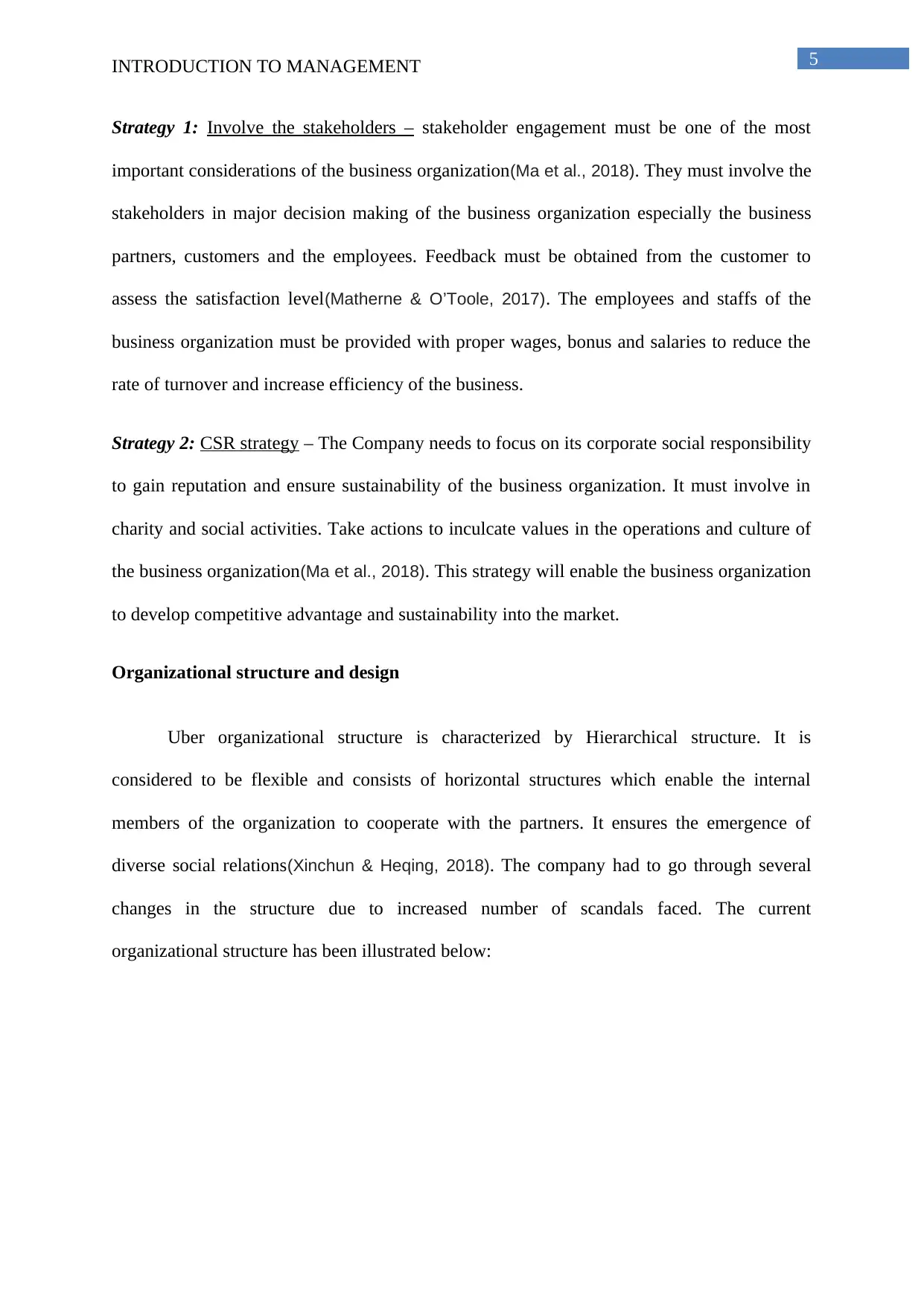
5INTRODUCTION TO MANAGEMENT
Strategy 1: Involve the stakeholders – stakeholder engagement must be one of the most
important considerations of the business organization(Ma et al., 2018). They must involve the
stakeholders in major decision making of the business organization especially the business
partners, customers and the employees. Feedback must be obtained from the customer to
assess the satisfaction level(Matherne & O’Toole, 2017). The employees and staffs of the
business organization must be provided with proper wages, bonus and salaries to reduce the
rate of turnover and increase efficiency of the business.
Strategy 2: CSR strategy – The Company needs to focus on its corporate social responsibility
to gain reputation and ensure sustainability of the business organization. It must involve in
charity and social activities. Take actions to inculcate values in the operations and culture of
the business organization(Ma et al., 2018). This strategy will enable the business organization
to develop competitive advantage and sustainability into the market.
Organizational structure and design
Uber organizational structure is characterized by Hierarchical structure. It is
considered to be flexible and consists of horizontal structures which enable the internal
members of the organization to cooperate with the partners. It ensures the emergence of
diverse social relations(Xinchun & Heqing, 2018). The company had to go through several
changes in the structure due to increased number of scandals faced. The current
organizational structure has been illustrated below:
Strategy 1: Involve the stakeholders – stakeholder engagement must be one of the most
important considerations of the business organization(Ma et al., 2018). They must involve the
stakeholders in major decision making of the business organization especially the business
partners, customers and the employees. Feedback must be obtained from the customer to
assess the satisfaction level(Matherne & O’Toole, 2017). The employees and staffs of the
business organization must be provided with proper wages, bonus and salaries to reduce the
rate of turnover and increase efficiency of the business.
Strategy 2: CSR strategy – The Company needs to focus on its corporate social responsibility
to gain reputation and ensure sustainability of the business organization. It must involve in
charity and social activities. Take actions to inculcate values in the operations and culture of
the business organization(Ma et al., 2018). This strategy will enable the business organization
to develop competitive advantage and sustainability into the market.
Organizational structure and design
Uber organizational structure is characterized by Hierarchical structure. It is
considered to be flexible and consists of horizontal structures which enable the internal
members of the organization to cooperate with the partners. It ensures the emergence of
diverse social relations(Xinchun & Heqing, 2018). The company had to go through several
changes in the structure due to increased number of scandals faced. The current
organizational structure has been illustrated below:
⊘ This is a preview!⊘
Do you want full access?
Subscribe today to unlock all pages.

Trusted by 1+ million students worldwide
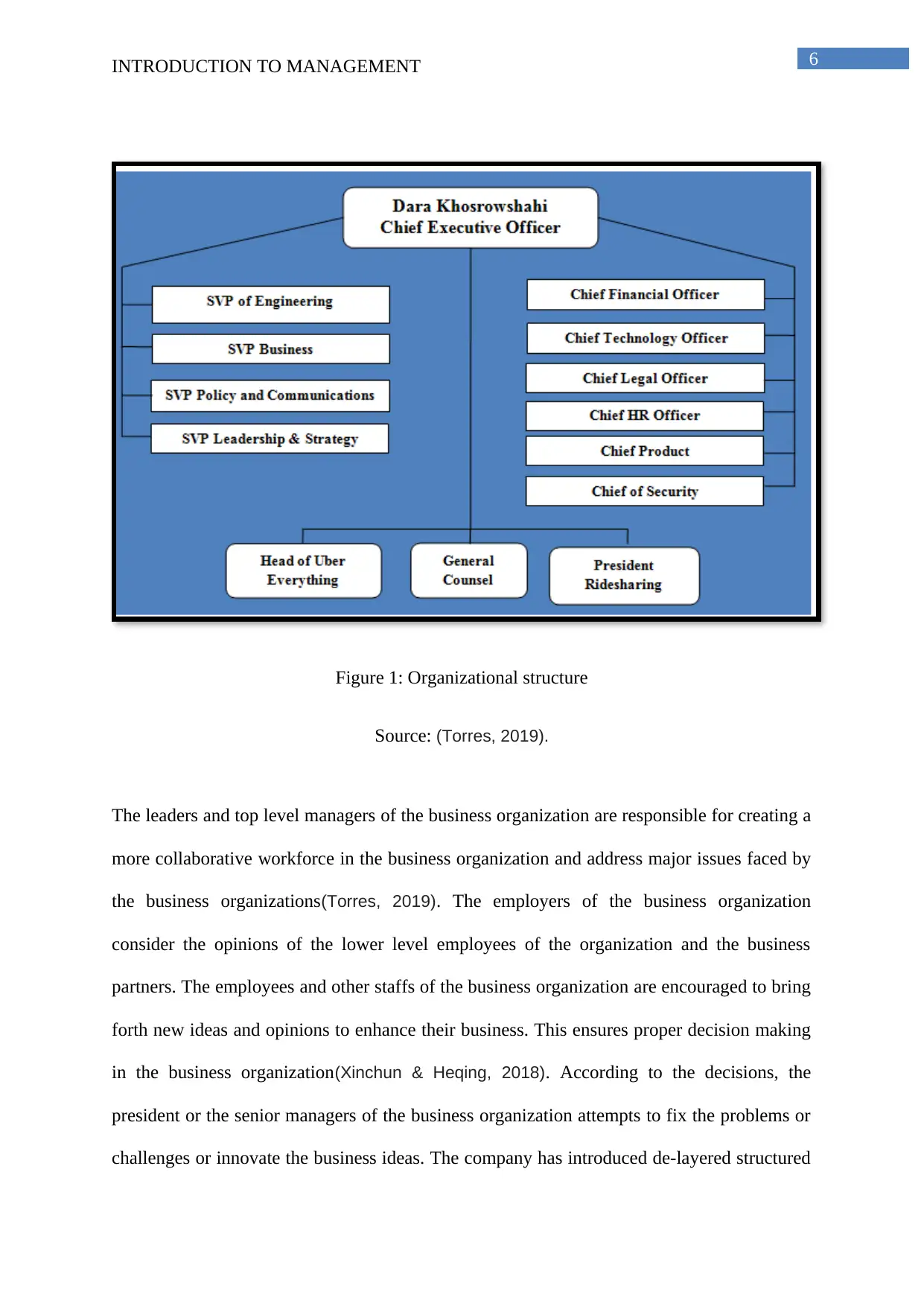
6INTRODUCTION TO MANAGEMENT
Figure 1: Organizational structure
Source: (Torres, 2019).
The leaders and top level managers of the business organization are responsible for creating a
more collaborative workforce in the business organization and address major issues faced by
the business organizations(Torres, 2019). The employers of the business organization
consider the opinions of the lower level employees of the organization and the business
partners. The employees and other staffs of the business organization are encouraged to bring
forth new ideas and opinions to enhance their business. This ensures proper decision making
in the business organization(Xinchun & Heqing, 2018). According to the decisions, the
president or the senior managers of the business organization attempts to fix the problems or
challenges or innovate the business ideas. The company has introduced de-layered structured
Figure 1: Organizational structure
Source: (Torres, 2019).
The leaders and top level managers of the business organization are responsible for creating a
more collaborative workforce in the business organization and address major issues faced by
the business organizations(Torres, 2019). The employers of the business organization
consider the opinions of the lower level employees of the organization and the business
partners. The employees and other staffs of the business organization are encouraged to bring
forth new ideas and opinions to enhance their business. This ensures proper decision making
in the business organization(Xinchun & Heqing, 2018). According to the decisions, the
president or the senior managers of the business organization attempts to fix the problems or
challenges or innovate the business ideas. The company has introduced de-layered structured
Paraphrase This Document
Need a fresh take? Get an instant paraphrase of this document with our AI Paraphraser

7INTRODUCTION TO MANAGEMENT
in the organization and thereby ensuring flexibility. This structure of the business
organization enables the business organization to respond to certain changes occurring in the
external and internal business environment(Wallsten, 2015). This structure also enables the
business organization to have faster flow of communication between the top level
management of the organization and the lower level employees.
Motivating employees
The employees and the business partners are key stakeholders of the business
organization. They must be given high priority in the organization and reduce the level of
conflicts (Wallsten, 2015). They must be motivated with higher wages, salaries and other non
monetary benefits so as to keep them satisfied in the business organization. Satisfied
employees are essential to carry out the business effectively without conflicts. Therefore, the
business organization must implement strategies such as additional payment for overtime,
employee engagement schemes, recognition and appreciation (Matherne & O’Tool, 2017).
These strategies will keep the employees and the staffs motivated and reduce employee
turnover rates in the organization. The management must assess their feedback and consider
their opinions in any decision making process of the organization.
Controls and recommendations
Considering the threats and opportunities from the external business environment, it
has been identified that the business organization has been facing various issues considering
in the organization and thereby ensuring flexibility. This structure of the business
organization enables the business organization to respond to certain changes occurring in the
external and internal business environment(Wallsten, 2015). This structure also enables the
business organization to have faster flow of communication between the top level
management of the organization and the lower level employees.
Motivating employees
The employees and the business partners are key stakeholders of the business
organization. They must be given high priority in the organization and reduce the level of
conflicts (Wallsten, 2015). They must be motivated with higher wages, salaries and other non
monetary benefits so as to keep them satisfied in the business organization. Satisfied
employees are essential to carry out the business effectively without conflicts. Therefore, the
business organization must implement strategies such as additional payment for overtime,
employee engagement schemes, recognition and appreciation (Matherne & O’Tool, 2017).
These strategies will keep the employees and the staffs motivated and reduce employee
turnover rates in the organization. The management must assess their feedback and consider
their opinions in any decision making process of the organization.
Controls and recommendations
Considering the threats and opportunities from the external business environment, it
has been identified that the business organization has been facing various issues considering
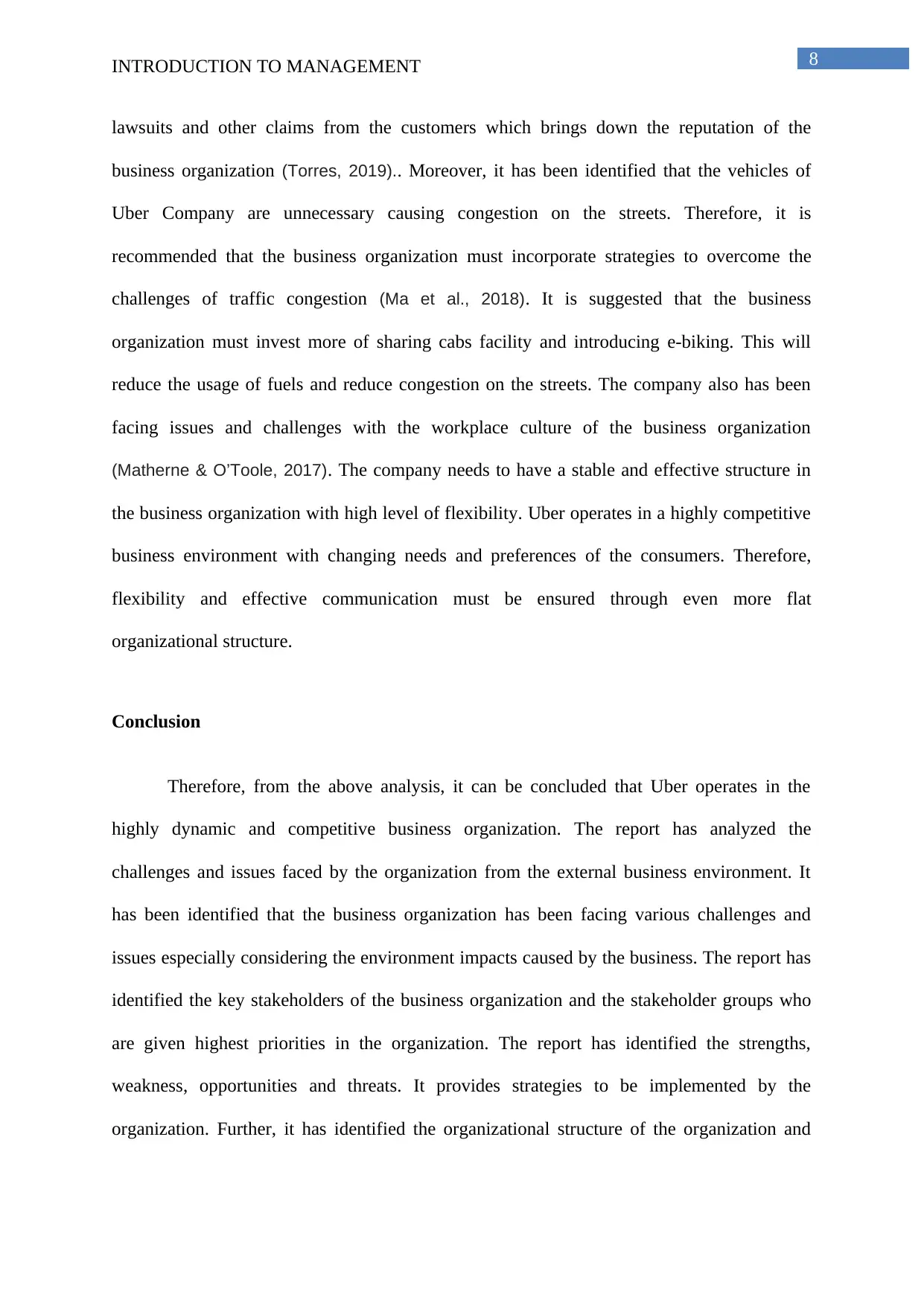
8INTRODUCTION TO MANAGEMENT
lawsuits and other claims from the customers which brings down the reputation of the
business organization (Torres, 2019).. Moreover, it has been identified that the vehicles of
Uber Company are unnecessary causing congestion on the streets. Therefore, it is
recommended that the business organization must incorporate strategies to overcome the
challenges of traffic congestion (Ma et al., 2018). It is suggested that the business
organization must invest more of sharing cabs facility and introducing e-biking. This will
reduce the usage of fuels and reduce congestion on the streets. The company also has been
facing issues and challenges with the workplace culture of the business organization
(Matherne & O’Toole, 2017). The company needs to have a stable and effective structure in
the business organization with high level of flexibility. Uber operates in a highly competitive
business environment with changing needs and preferences of the consumers. Therefore,
flexibility and effective communication must be ensured through even more flat
organizational structure.
Conclusion
Therefore, from the above analysis, it can be concluded that Uber operates in the
highly dynamic and competitive business organization. The report has analyzed the
challenges and issues faced by the organization from the external business environment. It
has been identified that the business organization has been facing various challenges and
issues especially considering the environment impacts caused by the business. The report has
identified the key stakeholders of the business organization and the stakeholder groups who
are given highest priorities in the organization. The report has identified the strengths,
weakness, opportunities and threats. It provides strategies to be implemented by the
organization. Further, it has identified the organizational structure of the organization and
lawsuits and other claims from the customers which brings down the reputation of the
business organization (Torres, 2019).. Moreover, it has been identified that the vehicles of
Uber Company are unnecessary causing congestion on the streets. Therefore, it is
recommended that the business organization must incorporate strategies to overcome the
challenges of traffic congestion (Ma et al., 2018). It is suggested that the business
organization must invest more of sharing cabs facility and introducing e-biking. This will
reduce the usage of fuels and reduce congestion on the streets. The company also has been
facing issues and challenges with the workplace culture of the business organization
(Matherne & O’Toole, 2017). The company needs to have a stable and effective structure in
the business organization with high level of flexibility. Uber operates in a highly competitive
business environment with changing needs and preferences of the consumers. Therefore,
flexibility and effective communication must be ensured through even more flat
organizational structure.
Conclusion
Therefore, from the above analysis, it can be concluded that Uber operates in the
highly dynamic and competitive business organization. The report has analyzed the
challenges and issues faced by the organization from the external business environment. It
has been identified that the business organization has been facing various challenges and
issues especially considering the environment impacts caused by the business. The report has
identified the key stakeholders of the business organization and the stakeholder groups who
are given highest priorities in the organization. The report has identified the strengths,
weakness, opportunities and threats. It provides strategies to be implemented by the
organization. Further, it has identified the organizational structure of the organization and
⊘ This is a preview!⊘
Do you want full access?
Subscribe today to unlock all pages.

Trusted by 1+ million students worldwide
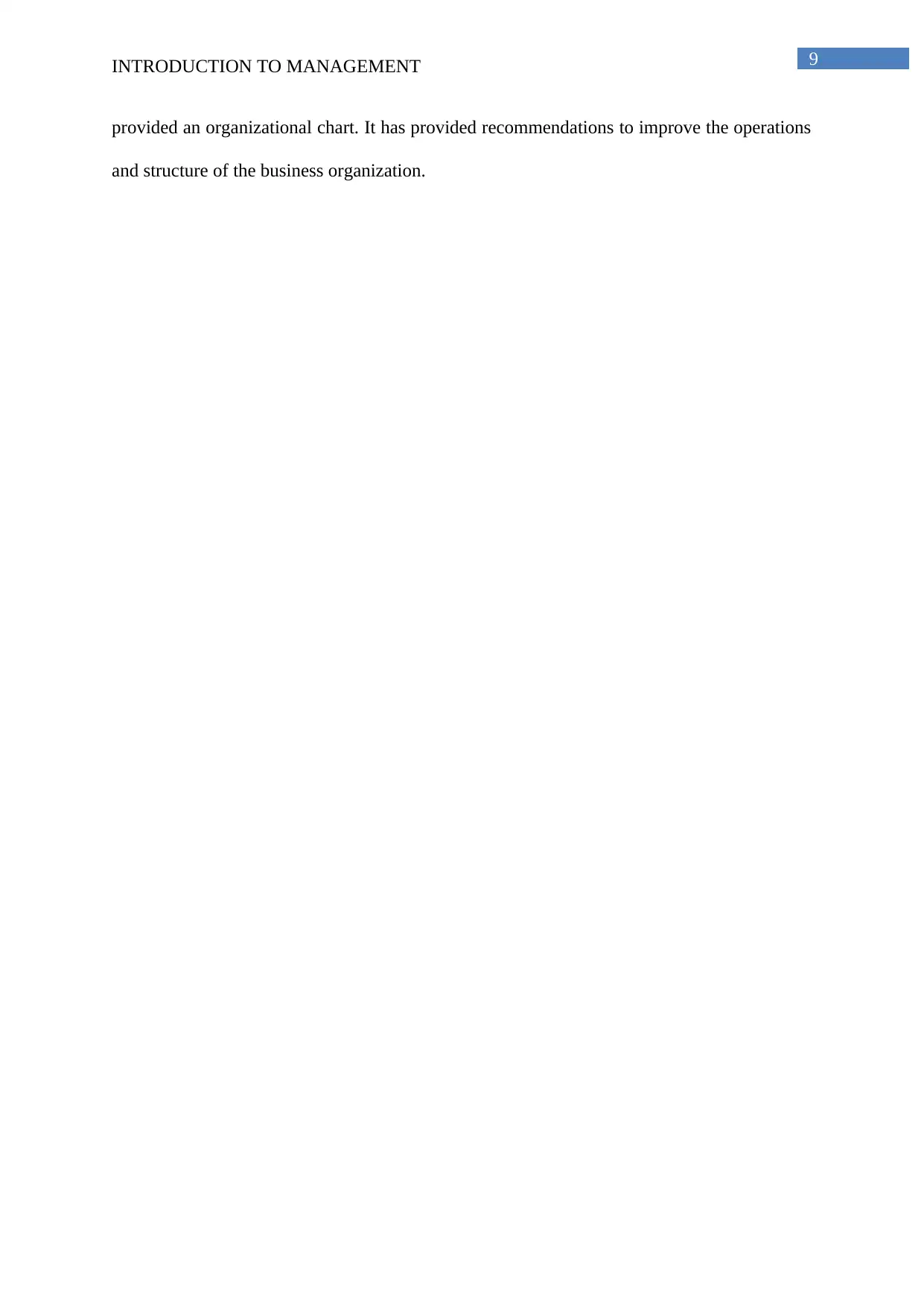
9INTRODUCTION TO MANAGEMENT
provided an organizational chart. It has provided recommendations to improve the operations
and structure of the business organization.
provided an organizational chart. It has provided recommendations to improve the operations
and structure of the business organization.
Paraphrase This Document
Need a fresh take? Get an instant paraphrase of this document with our AI Paraphraser

10INTRODUCTION TO MANAGEMENT
References
Fan, Y., Xia, M., Zhang, Y., & Chen, Y. (2019). The influence of social embeddedness on
organizational legitimacy and the sustainability of the globalization of the sharing
economic platform: Evidence from Uber China. Resources, Conservation and
Recycling, 151, 104490.
Hanrahan, B. V., Ma, N. F., & Yuan, C. W. (2018). The roots of bias on Uber. arXiv preprint
arXiv:1803.08579.
Jordan, J. M. (2017). Challenges to large-scale digital organization: the case of
Uber. Journal of Organization Design, 6(1), 11.
Khan, M., & Islam, M. (2018). Partners and drivers attraction and retention Strategies of
Uber.
Khetan, R., Ilavarasan, P. V., & Kar, A. K. (2019). Analyzing Customer Engagement Using
Twitter Analytics: A Case of Uber Car-Hailing Services. In Digital Transformation for
a Sustainable Society in the 21st Century: 18th IFIP WG 6.11 Conference on E-
Business, E-Services, and E-Society, I3E 2019, Trondheim, Norway, September 18-
20, 2019, Proceedings (Vol. 11701, p. 404). Springer Nature.
Ma, N. F., Yuan, C. W., Ghafurian, M., & Hanrahan, B. V. (2018, April). Using Stakeholder
Theory to Examine Drivers' Stake in Uber. In Proceedings of the 2018 CHI
Conference on Human Factors in Computing Systems (pp. 1-12).
Matherne, B. P., & O’Toole, J. (2017). Uber: aggressive management for growth. The CASE
Journal.
Torres, C. (2019). Challenges in the study of stress.
uber.com. (2017). Uber’s new cultural norms. Retrieved from
https://www.uber.com/newsroom/ubers-new-cultural-norms/
uber.com. (2020). About us. Retrieved from https://www.uber.com/in/en/about/
References
Fan, Y., Xia, M., Zhang, Y., & Chen, Y. (2019). The influence of social embeddedness on
organizational legitimacy and the sustainability of the globalization of the sharing
economic platform: Evidence from Uber China. Resources, Conservation and
Recycling, 151, 104490.
Hanrahan, B. V., Ma, N. F., & Yuan, C. W. (2018). The roots of bias on Uber. arXiv preprint
arXiv:1803.08579.
Jordan, J. M. (2017). Challenges to large-scale digital organization: the case of
Uber. Journal of Organization Design, 6(1), 11.
Khan, M., & Islam, M. (2018). Partners and drivers attraction and retention Strategies of
Uber.
Khetan, R., Ilavarasan, P. V., & Kar, A. K. (2019). Analyzing Customer Engagement Using
Twitter Analytics: A Case of Uber Car-Hailing Services. In Digital Transformation for
a Sustainable Society in the 21st Century: 18th IFIP WG 6.11 Conference on E-
Business, E-Services, and E-Society, I3E 2019, Trondheim, Norway, September 18-
20, 2019, Proceedings (Vol. 11701, p. 404). Springer Nature.
Ma, N. F., Yuan, C. W., Ghafurian, M., & Hanrahan, B. V. (2018, April). Using Stakeholder
Theory to Examine Drivers' Stake in Uber. In Proceedings of the 2018 CHI
Conference on Human Factors in Computing Systems (pp. 1-12).
Matherne, B. P., & O’Toole, J. (2017). Uber: aggressive management for growth. The CASE
Journal.
Torres, C. (2019). Challenges in the study of stress.
uber.com. (2017). Uber’s new cultural norms. Retrieved from
https://www.uber.com/newsroom/ubers-new-cultural-norms/
uber.com. (2020). About us. Retrieved from https://www.uber.com/in/en/about/
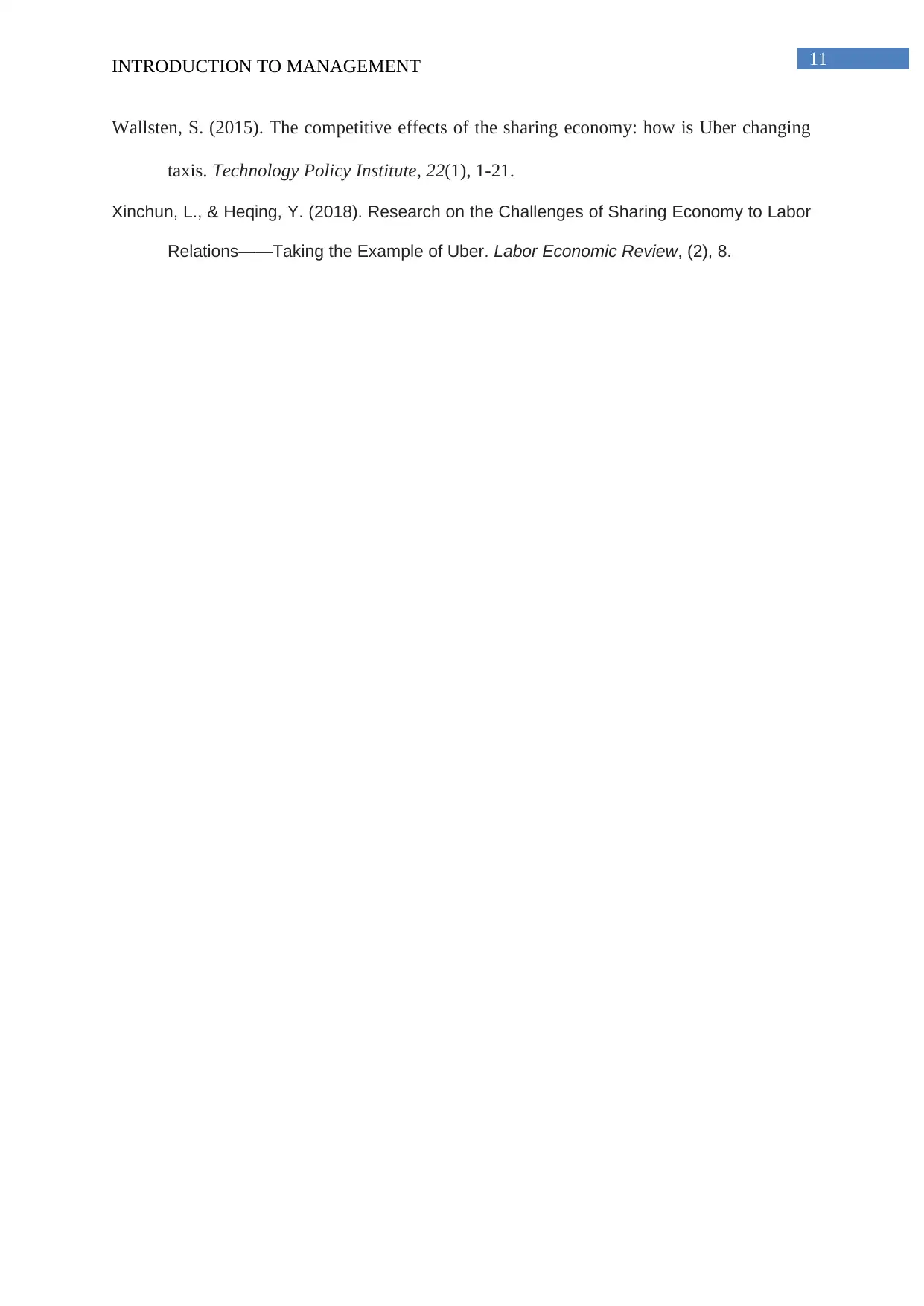
11INTRODUCTION TO MANAGEMENT
Wallsten, S. (2015). The competitive effects of the sharing economy: how is Uber changing
taxis. Technology Policy Institute, 22(1), 1-21.
Xinchun, L., & Heqing, Y. (2018). Research on the Challenges of Sharing Economy to Labor
Relations——Taking the Example of Uber. Labor Economic Review, (2), 8.
Wallsten, S. (2015). The competitive effects of the sharing economy: how is Uber changing
taxis. Technology Policy Institute, 22(1), 1-21.
Xinchun, L., & Heqing, Y. (2018). Research on the Challenges of Sharing Economy to Labor
Relations——Taking the Example of Uber. Labor Economic Review, (2), 8.
⊘ This is a preview!⊘
Do you want full access?
Subscribe today to unlock all pages.

Trusted by 1+ million students worldwide
1 out of 12
Related Documents
Your All-in-One AI-Powered Toolkit for Academic Success.
+13062052269
info@desklib.com
Available 24*7 on WhatsApp / Email
![[object Object]](/_next/static/media/star-bottom.7253800d.svg)
Unlock your academic potential
Copyright © 2020–2025 A2Z Services. All Rights Reserved. Developed and managed by ZUCOL.



